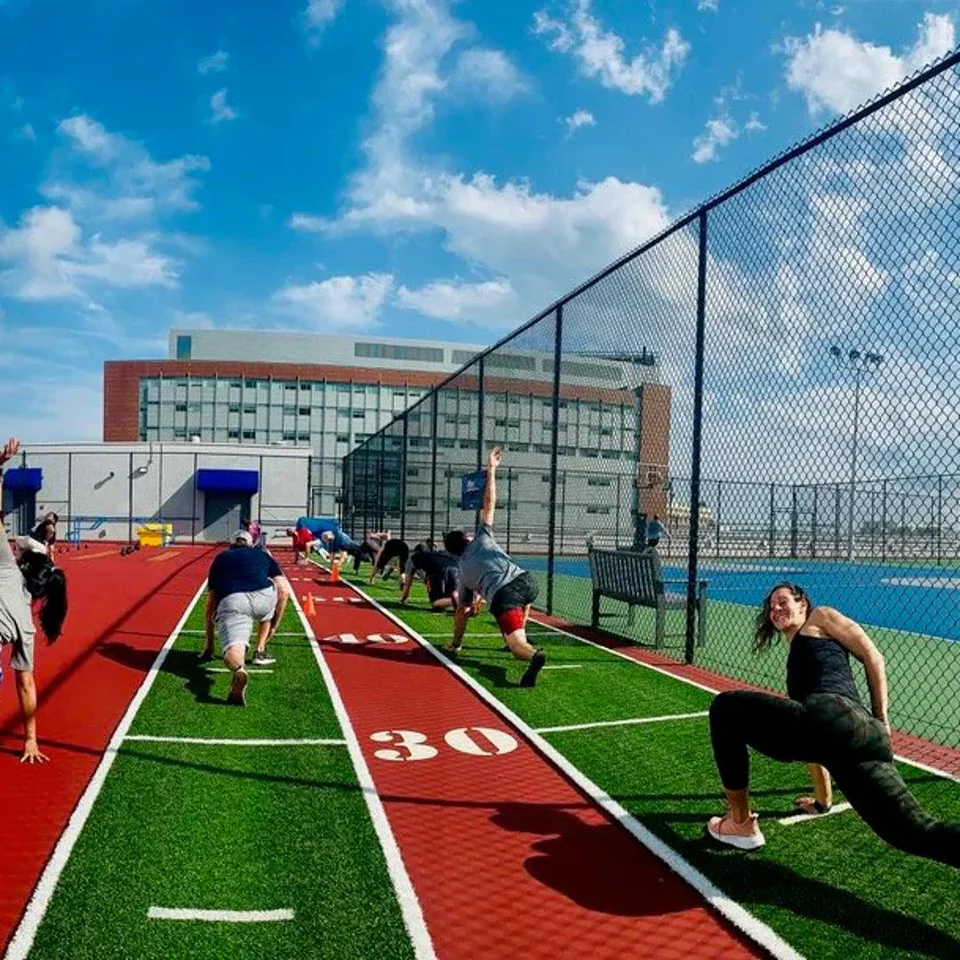Setting up an outdoor gym is a great way to stay fit while enjoying fresh air. However, choosing the right flooring is crucial for safety, durability, and performance. Unlike indoor gyms, outdoor flooring must withstand weather, heavy equipment, and constant use.
This guide will walk you through the best options, installation tips, and maintenance steps for outdoor gym flooring.
The Main Advantage of Outdoor Gym Flooring
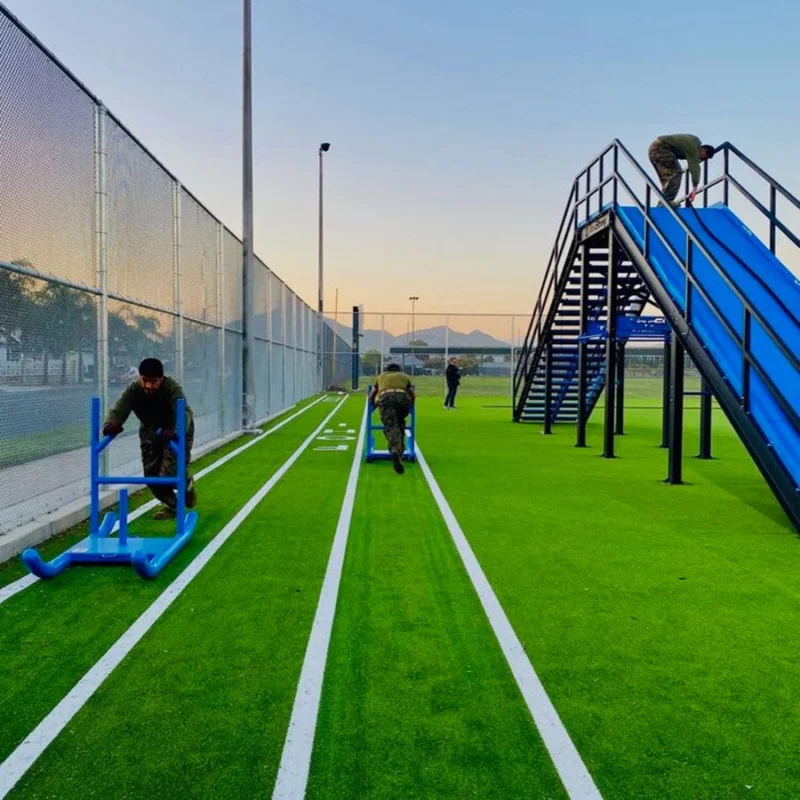
Outdoor gym flooring protects users from injuries by providing a stable, slip-resistant surface. It also absorbs shock, reducing joint strain during high-impact workouts. Since outdoor floors face rain, sun, and temperature changes, they must be weather-resistant. The right flooring also prevents equipment damage and reduces noise, making it ideal for home and commercial gyms.
Step 1: Choose the Right Material
The flooring material sets the tone for the entire gym space. Each material offers distinct features that cater to different goals, climates, and weight capacities.
Rubber Tiles
Key Features
- Excellent shock absorption for high-impact activities
- Non-slip surface ideal for all weather conditions
- Interlocking design ensures fast and firm installation
Considerations
- Must include UV protection for longevity under sun exposure
- Choose commercial-grade thickness for weightlifting zones
- Avoid soft blends for areas with constant foot traffic
Artificial Turf
Key Features
- Delivers a grass-like aesthetic without maintenance
- Effective drainage system reduces water retention
- Ideal for sled pushes, agility ladders, and mobility drills
Considerations
- Needs a proper underlay for shock absorption
- Can heat up under direct sunlight
- Edges must be securely fastened to avoid curling
Interlocking Mats
Key Features
- Lightweight and portable for seasonal or temporary setups
- Made from dense foam or recycled rubber
- Easy to move and adjust without tools
Considerations
- Less durable under heavy machinery
- Require flat surfaces for secure connection
- Should be stored away during extreme weather for protection
Poured Rubber or Rubber-Coated Concrete
Key Features
- Permanent, seamless flooring solution for professional setups
- Resistant to weather, UV rays, and water
- Supports heavy machines without shifting or cracking
Considerations
- Requires professional-grade tools and curing process
- High upfront cost but minimal maintenance afterward
- Limited flexibility after installation
Step 2: Prepare the Ground
Laying strong flooring depends on the condition of the base. No surface should remain untreated before installation. Begin with foundational groundwork.
Remove Debris and Level the Surface
- Clear all rocks, roots, and uneven sections
- Use a compactor to press soft soil into a firm base
- Avoid installing directly over soft or uneven ground
Add a Base Layer
- Apply crushed stone or compacted gravel for improved drainage
- Create a slight slope away from the gym zone for runoff
- Ensure thickness between 2 to 4 inches for stability
Check for Proper Drainage
- Water buildup leads to mold, warping, and reduced safety
- Create drainage channels if water tends to collect
- Add a layer of landscape fabric to prevent weed growth and moisture retention
Step 3: Install the Flooring Correctly
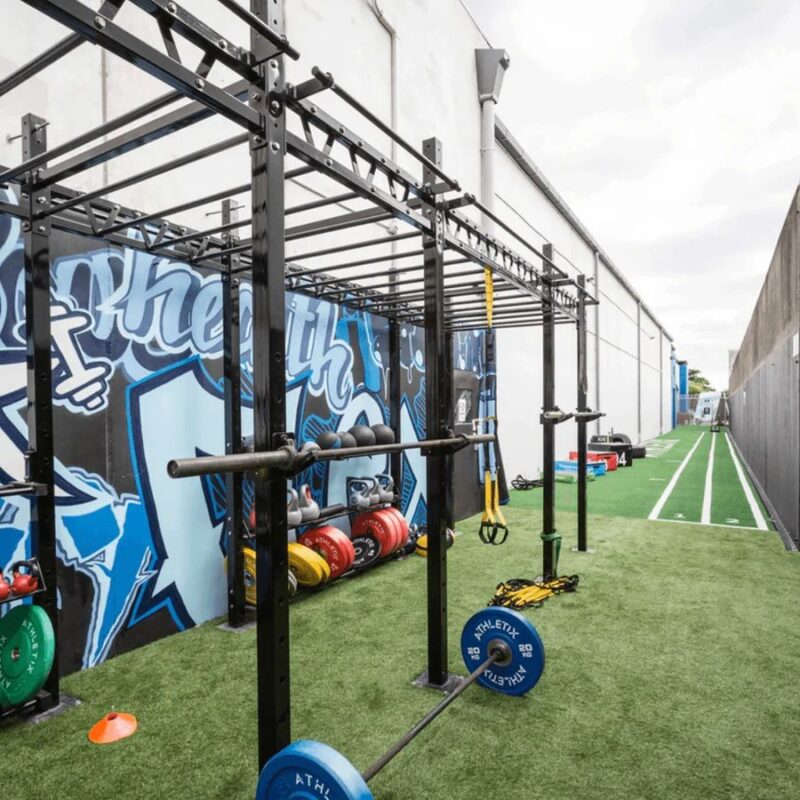
The installation method depends on the flooring type. Each one requires different preparation, connection techniques, and edge finishing.
Rubber Tiles and Interlocking Mats
Installation Method
- Place tiles on leveled ground one section at a time
- Align tightly using the interlocking edges
- For permanent setups, use outdoor-rated adhesive or edge spikes
Additional Tips
- Allow 24 hours for tiles to settle before equipment setup
- Leave expansion gaps near walls to adjust to temperature changes
- Test each section by jumping lightly to check for movement
Artificial Turf
Installation Method
- Roll turf across the prepared base and cut to fit the layout
- Secure edges using galvanized nails, staples, or heavy-duty glue
- Add a rubber underlayment below for extra cushioning
Additional Tips
- Use infill material like silica sand for added weight and stability
- Comb the fibers with a power broom to create a uniform surface
- Rinse after installation to remove loose debris
Poured Rubber or Rubber-Coated Concrete
Installation Method
- Hire a flooring specialist with outdoor experience
- Ensure the substrate is leveled and fully dry
- Mix and pour rubber compound evenly in sections
Additional Tips
- Follow curing time strictly, which can vary from 24 to 72 hours
- Avoid foot traffic until fully hardened
- Apply a protective sealant for UV and weather protection
Step 4: Maintain Your Outdoor Gym Flooring
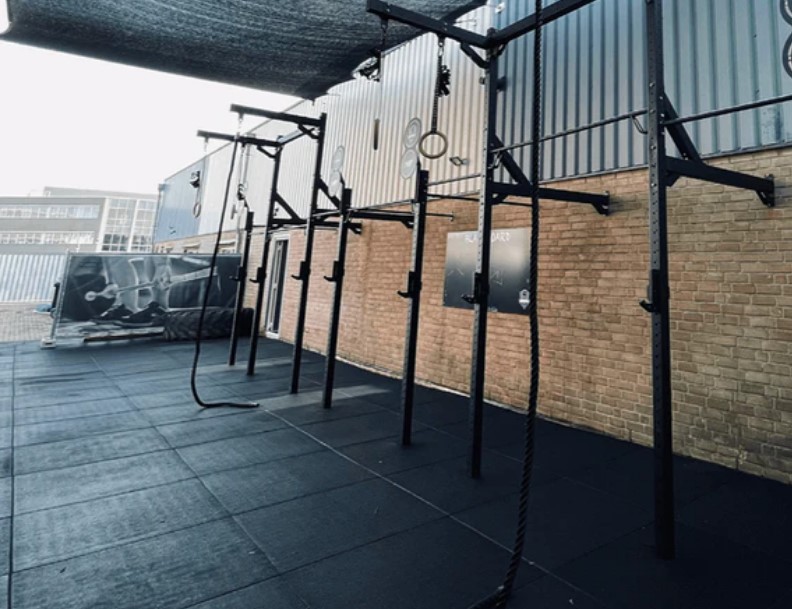
Long-lasting flooring depends on regular maintenance and seasonal care. A well-kept surface boosts performance and avoids injury risks.
Routine Cleaning
Weekly Tasks
- Sweep leaves, sand, and small rocks
- Hose off with water to clear surface dust
- Use a neutral-pH cleaner on rubber or turf to remove sweat residue
Monthly Tasks
- Deep clean with a soft brush or mop
- Inspect seams and adhesive points
- Check drainage areas and clear clogs
Damage Checks and Quick Repairs
- Examine for cracks, lifted tiles, or punctures
- Replace broken sections immediately
- Keep extra tiles or turf patches on-site for quick fixes
Weather Protection
- Install a shade canopy or tarp cover for UV-heavy regions
- Store foam mats indoors during heavy snow or extreme temperatures
- Use corner edging to reduce water seepage under flooring
Key Factors to Consider Before Choosing Outdoor Gym Flooring
Planning the foundation of your gym goes beyond surface materials. Several core factors shape long-term performance, safety, and cost-effectiveness.
Evaluate Your Workout Style
- Powerlifting and CrossFit require thick, shock-absorbent surfaces
- Cardio or agility drills benefit from smooth turf or cushioned mats
- Stretch zones and yoga areas need a firm yet comfortable texture
Each activity creates pressure in different zones, which should guide material selection.
Consider Local Climate Conditions
- Regions with frequent rain need flooring with high drainage capacity
- Sunny climates demand UV-resistant materials to prevent fading
- Cold areas may require flexible flooring that can endure freeze-thaw cycles
Outdoor floors must withstand temperature swings and natural elements without breaking down or losing grip.
Measure the Workout Area Precisely
- Accurate dimensions avoid wasted material and ensure a tight fit
- Use chalk lines or spray paint to outline the exact area
- Sketch a layout plan to anticipate seams, edges, and transitions
Correct measurement helps with budgeting and reduces long-term issues with surface movement or misalignment.
Check Load Requirements for Equipment
- Rubber tiles must be dense enough to hold barbells, racks, or machines
- Avoid soft mats in zones with repeated drops or machine vibration
- For multi-use areas, consider mixed flooring zones with varying thickness
Every piece of equipment applies force differently. Surface strength must match equipment weight and frequency of use.
Conclusion
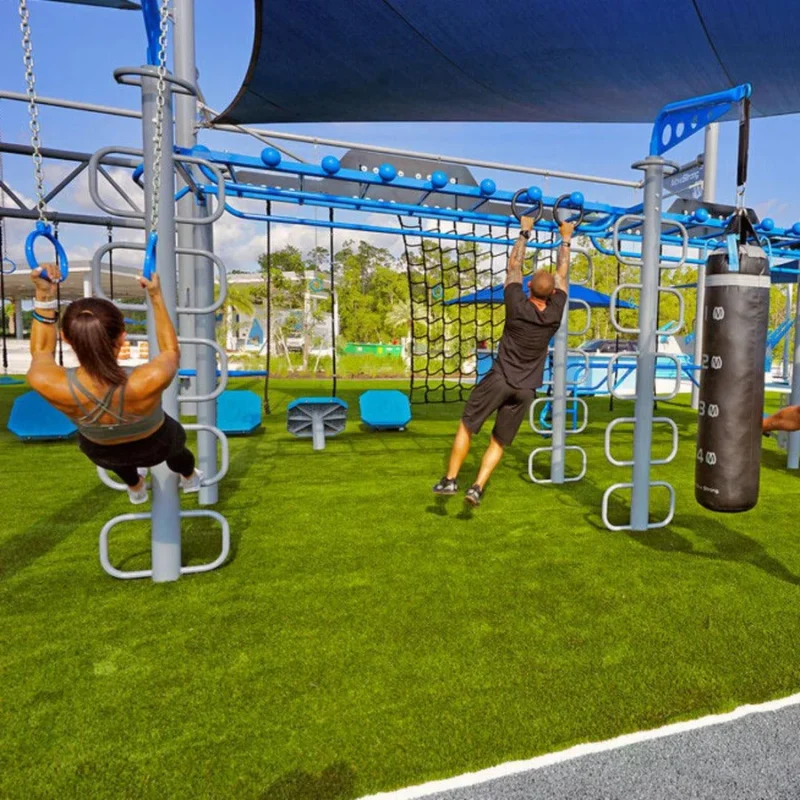
Choosing the right outdoor gym flooring ensures safety, durability, and better workouts. Whether you pick rubber tiles, artificial turf, or interlocking mats, proper installation and maintenance will keep your gym in top shape. For high-quality options, explore premium outdoor gym flooring designed for heavy-duty use. Invest in the best flooring today and enjoy a long-lasting outdoor fitness space!

